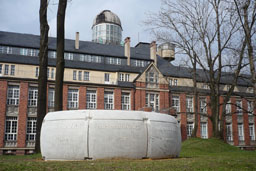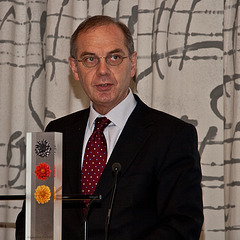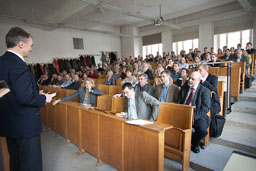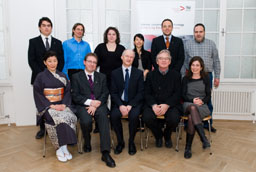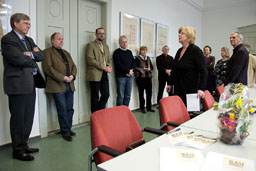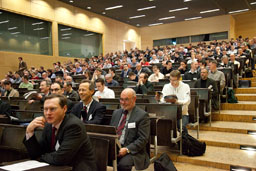
Blick in den Hörsaal bei der gut besuchten Stahlbaufachtagung
Am 25. März fand im Hörsaalzentrum der TU Dresden die Dresdner Stahlbaufachtagung 2010 mit dem Thema „Stahlhochbaukonstruktionen im europäischen Kontext“ statt. Die Veranstaltung erlebte ihre inzwischen 4. Auflage und fand mit ca. 270 Teilnehmern eine ausgezeichnete Resonanz.
Die Einführung der Eurocodes und der europäischen Produkt- und Ausführungsnormen führt zu weitreichenden Veränderungen für die Bemessung und Ausführung von Stahlbaukonstruktionen. Der Eurocode 3 liegt in allen Teilen im Weißdruck vor. Die Nationalen Anhänge zu den Normenteilen werden im Laufe des Jahres weitestgehend fertiggestellt und veröffentlicht sein. Das Zurückziehen der entgegenstehenden nationalen Normen soll Ende des Jahres eingeleitet werden und im Anschluss die bauaufsichtliche Einführung erfolgen. Vor diesem Hintergrund widmete sich die Dresdener Stahlbaufachtagung 2010 der Stabilitätsbemessung, den Kranbahnanlagen, Schweißverbindungen und Stahlhohlprofilkonstruktionen nach DIN EN 1993. Im zweiten Teil wurden Ausführung und Korrosionsschutz von Stahlkonstruktionen erläutert, Schadensfälle im Stahlbau sowie das imposante Stahltragwerk der Riesentropenhalle Gondwanaland des Leipziger Zoos vorgestellt.
Nach der Eröffnung der Veranstaltung durch Dipl.-Ing. Ulrich Werner, Direktor der Bauakademie Sachsen, sprach Dipl.-Ing. Hans Ulrich Batzke, Präsident des Deutschen Stahlbauverbandes, die Grußworte. Er unterstrich in seiner Rede die Vorteile der Stahlbauweise in Bezug auf die technischen Möglichkeiten, die gestalterischen Qualitäten und insbesondere in Verbindung mit der aktuellen Nachhaltigkeitsdiskussion. Dr. Bernhard Hauke, Geschäftsführer von Bauforumstahl, übernahm fachkundig die Moderation und führte durch die Tagung. Die Reihe der Fachvorträge eröffnete Prof. Dr. Richard Stroetmann, Direktor des Instituts für Stahl- und Holzbau der TU Dresden und Spiritus Rector der Stahlbaufachtagung, mit einer kurzen Einführung über den Bearbeitungsstand der Nationalen Anhänge und die baurechtliche Umsetzung der Eurocodes. Inhalt seines anschließenden Vortrages waren die Stabilitätsberechnungen von Stabtragwerken nach DIN EN 1993-1-1. Dipl.-Ing. Benjamin Braun, ehemals am Institut für Konstruktion und Entwurf der Universität Stuttgart und jetzt an der BAW in Karlsruhe, setzte mit einem Vortrag zum Plattenbeulen nach DIN EN 1993-1-5 fort. Die Morgensitzung wurde mit Ausführungen von Dr.-Ing. Holger Flederer, Oberingenieur am Lehrstuhl für Stahlbau der Technischen Universität Dresden, beendet. Inhalte seines Vortrages waren die Berechnung und Bemessung von Kranbahnen nach DIN EN 1993-6.
In der Vormittagssitzung wurden Regelungen zu geschweißten Verbindungen nach Eurocode 3, Teil 1-8 erörtert. Die Vorträge von Dr.-Ing. Michael Volz, wissenschaftlicher Mitarbeiter der Versuchsanstalt für Stahl, Holz und Steine vom Karlsruher Institut für Technologie (KIT), der die Grundlagen zur Bemessung und Ausführung von geschweißten Verbindungen erläuterte, und Dr.-Ing. Stefan Herion, ebenfalls vom KIT, der sich speziell der Bemessung und Konstruktion von Stahlhohlprofilverbindungen widmete, ergänzten sich in idealer Weise.
Den ersten Nachmittagsblock eröffnete Dr.-Ing. Michael Volz mit einem weiteren Referat. Inhalt des Vortrages war die Ausführung von Stahlkonstruktionen nach DIN EN 1090-2, der unter anderem die Unterschiede und Gemeinsamkeiten bzgl. der gegenwärtig gültigen nationalen Normen DIN 18800-7 herausstellte sowie die damit verbundenen Konsequenzen für Unternehmen, die im Stahlbau fertigen. Dr. Andreas Schütz, Geschäftsführer des Instituts für Korrosionsschutz Dresden GmbH, gab anschließend einen Überblick über typische Korrosionsschutzbeschichtungen im Stahlbau und erläuterte die Regelungen für die Systemauswahl und Ausführung der EN ISO 12944 an anschaulichen Beispielen und Schadensfällen.
Die letzte Vortragsgruppe begann Prof. Dr.-Ing. Steffen Kind von der Fakultät Bauingenieurwesen der Hochschule Darmstadt mit ausgewählten Schadensfällen im Stahlbau. Nach einer Strukturierung von Schadensursachen und Schadenskategorien wies er in unterhaltsamer und anschaulicher Weise auf typische Fehler bei der Planung und Ausführung hin und verdeutlichte an Schadensbeispielen deren Konsequenzen.
Dipl.-Ing. Diethard Kiehn, Projektleiter der Eiffel Deutschland Stahltechnologie GmbH, zeigte anschließend mit seinem Vortrag zum Stahltragwerk der Riesentropenhalle Gondwanaland im Leipziger Zoo ein herausragendes Beispiel eines weitgespannten Stahlgittertragwerks aus Stahlhohlprofilen mit ETFE-Folienkissen, das künftig das Highlight für die Besucher des Zoos sein wird.

